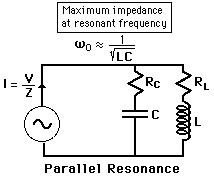Parallel Resonance
The resonance of a parallel RLC circuit is a bit more involved than the series resonance. The resonant frequency can be defined in three different ways, which converge on the same expression as the series resonant  frequency if the resista
frequency if the resista nce of the circuit is small.
nce of the circuit is small.
 RSS Feed (xml)
RSS Feed (xml)

Tidak ada komentar:
Posting Komentar